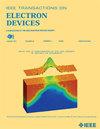Theoretical Model of Transient Current in CMOS Inverter Under IR Laser Pulse Responsible of Bitflip in FDSOI Technology
IF 2.9
2区 工程技术
Q2 ENGINEERING, ELECTRICAL & ELECTRONIC
引用次数: 0
Abstract
A theoretical model of the induced transient photocurrent in MOS transistor under laser illumination is proposed to predict an estimation of the incident power surface density of the laser required to create a bitflip. This model based on the physical effect of the laser interaction with the semiconductor material (silicon) takes into account the laser characteristics, the physical properties of the silicon, and the geometrical and technological parameters. The results highlight the volume effects, with a higher photocurrent level due to a higher total electron/hole pair generation for a thicker active layer, making the structures more sensitive to fault injection by pulsed IR laser, particularly for conventional bulk CMOS technologies and for FDSOI technologies based on FINFETs. This theoretical model combined with electrical model based on phototransistor is a good predictive tool in complements with TCAD simulations for studies of vulnerability analysis in advanced FDSOI silicon technologies and enables parametric analysis of physical phenomena related to the technology, in order to anticipate experimental studies of the vulnerability by laser fault injection of complex electronic systems.FDSOI技术中红外激光触发下CMOS逆变器瞬态电流理论模型
提出了激光照射下MOS晶体管中感应瞬态光电流的理论模型,以预测产生位翻转所需的激光入射功率表面密度的估计。该模型基于激光与半导体材料(硅)相互作用的物理效应,考虑了激光特性、硅的物理性质以及几何和工艺参数。结果强调了体积效应,由于更厚的有源层产生了更高的总电子/空穴对,因此光电流水平更高,使得结构对脉冲红外激光的故障注入更敏感,特别是对于传统的大块CMOS技术和基于finfet的FDSOI技术。该理论模型与基于光电晶体管的电气模型相结合,是一种很好的预测工具,可以与TCAD模拟相补充,用于先进FDSOI硅技术的脆弱性分析研究,并可以对与该技术相关的物理现象进行参数化分析,从而预测复杂电子系统激光故障注入脆弱性的实验研究。
本文章由计算机程序翻译,如有差异,请以英文原文为准。
求助全文
约1分钟内获得全文
求助全文
来源期刊

IEEE Transactions on Electron Devices
工程技术-工程:电子与电气
CiteScore
5.80
自引率
16.10%
发文量
937
审稿时长
3.8 months
期刊介绍:
IEEE Transactions on Electron Devices publishes original and significant contributions relating to the theory, modeling, design, performance and reliability of electron and ion integrated circuit devices and interconnects, involving insulators, metals, organic materials, micro-plasmas, semiconductors, quantum-effect structures, vacuum devices, and emerging materials with applications in bioelectronics, biomedical electronics, computation, communications, displays, microelectromechanics, imaging, micro-actuators, nanoelectronics, optoelectronics, photovoltaics, power ICs and micro-sensors. Tutorial and review papers on these subjects are also published and occasional special issues appear to present a collection of papers which treat particular areas in more depth and breadth.
 求助内容:
求助内容: 应助结果提醒方式:
应助结果提醒方式:


